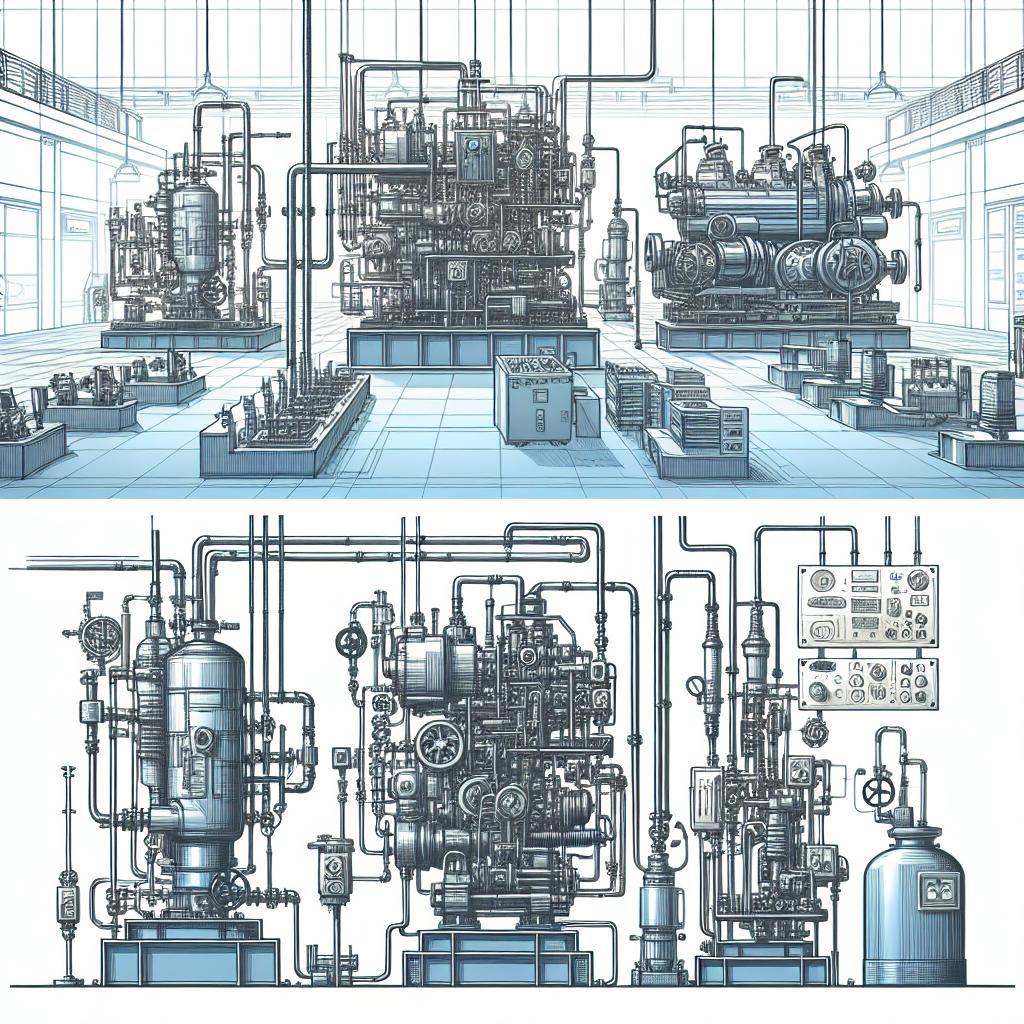How to Size an HVAC System: Finding the Perfect Fit for Your Space
Choosing the right HVAC system is not just about selecting a unit that looks sleek or promises energy efficiency; it’s about creating a comfortable haven within your walls. Imagine stepping into a space where the temperature is always just right—neither too hot nor too cold, where the air feels fresh, and you can focus on what truly matters. Yet, achieving this ideal comfort requires more than a simple guesswork or a one-size-fits-all approach. Properly sizing an HVAC system is an essential first step that ensures optimal performance, energy savings, and longevity of your investment. In this article, we’ll guide you through the intricacies of sizing an HVAC system, from understanding key terminology and calculating your home’s heating and cooling needs, to factors that influence system efficiency and performance. Whether you’re a homeowner embarking on a new project or a seasoned builder looking to refine your knowledge, join us as we demystify the process and help you find the perfect fit for your space.
Understanding Load Calculation for Optimal HVAC Sizing
To achieve the best performance from your HVAC system, accurate load calculations are essential. This process involves assessing various factors that contribute to a building’s heating and cooling requirements. Some key elements to consider include:
- Building Size: The total square footage plays a crucial role in determining the capacity needed.
- Insulation Levels: Well-insulated spaces require less energy to maintain comfortable temperatures.
- Air Infiltration: The amount of outside air that enters a building can affect the overall efficiency of the HVAC system.
- Occupancy: The number of occupants impacts both heat production and air quality considerations.
- Appliances and Lighting: Heat generated from electronics and lighting can significantly alter load requirements.
Once you’ve gathered this information, a detailed heat gain and loss analysis can be conducted, often utilizing software designed for this purpose. Here’s a simplified view of how to categorize your calculations:
| Calculation Type | Examples |
|---|---|
| Heat Gain | Sunlight through windows, internal heat from appliances |
| Heat Loss | Heat escaping through walls, ceilings, and floors |
By understanding and meticulously calculating these factors, homeowners and builders can ensure that an HVAC system operates efficiently, effectively delivering comfort while minimizing energy expenses.

Evaluating Climate and Geography for System Efficiency
When considering the efficiency of your HVAC system, it’s crucial to assess the unique characteristics of your local climate and geographical features. Different regions may experience varying temperature ranges, humidity levels, and seasonal weather patterns which can significantly impact how much cooling or heating your system will need to provide. Key factors to consider include:
- Temperature fluctuations: Identify the temperature extremes for summer and winter in your area.
- Humidity levels: Humid climates may require dehumidification efforts, while dry climates might need more cooling.
- Elevation: Higher altitudes can impact the heating requirements and the efficiency of air handling.
Another vital aspect is the local geography, including the presence of trees, bodies of water, and urban development. These elements can create microclimates that could influence your HVAC sizing. For instance, shaded properties may experience lower cooling demands, while homes exposed to wind might need more robust heating solutions. An effective way to consolidate this information is by using a comparative table:
| Geographic Feature | Impact on HVAC Sizing |
|---|---|
| Proximity to Water | Moderates temperature swings; may reduce heating needs. |
| Vegetation | Provides shade; can lower cooling energy use. |
| Urban Heat Islands | May increase cooling demands due to higher local temperatures. |

Exploring Different System Types and Their Sizing Needs
When considering HVAC systems, it’s essential to recognize that different types have unique characteristics and sizing needs. Central air conditioning systems are popular in residential applications, typically requiring comprehensive ductwork to distribute the conditioned air throughout the home. They rely on a balanced approach to ensure that energy efficiency and airflow are maintained across all areas. In contrast, ductless mini-split systems allow for zoning and targeted temperature control, making them an excellent choice for older homes without ductwork. These systems require careful calculation of the space they will serve, focusing on each zone’s specific heating or cooling load.
Another popular choice is the heat pump system, which can provide both heating and cooling functionalities. Heat pumps are generally sized according to their ability to transfer heat rather than generate it, making it crucial to account for factors such as outdoor temperature variations. Additionally, package units combine heating and cooling components in a single outdoor unit, simplifying installation but requiring a thorough assessment of the space to ensure adequate capacity. Regardless of the system type, a thorough load calculation is paramount to ensure comfort and efficiency. The following table summarizes some common HVAC system types and their key sizing considerations:
| System Type | Key Sizing Considerations |
|---|---|
| Central AC | Ductwork design and air distribution |
| Ductless Mini-Split | Zone-specific load calculations |
| Heat Pump | Outdoor temperature impact and efficiency |
| Package Unit | Overall heating and cooling capacity |

Navigating the Importance of Professional Installation and Maintenance
Ensuring your HVAC system is properly sized is only part of the equation; the true performance and longevity of your system depend heavily on professional installation and regular maintenance. Engaging skilled technicians not only guarantees that your unit functions at its optimal capacity but also complies with local codes and safety standards. This expertise minimizes the risk of common installation errors that can compromise efficiency, lead to premature breakdowns, and incur higher energy bills. A professional installer will meticulously assess your home’s layout, insulation, and other variables to customize the system to your specific needs.
Beyond the initial installation, keeping your HVAC system in peak condition requires ongoing maintenance services. These include:
- Regular Inspections: Catching minor issues before they escalate.
- Filter Replacements: Ensuring clean air flow and system efficiency.
- Coil Cleaning: Preventing dirt build-up that impacts performance.
- Refrigerant Checks: Maintaining the proper levels for cooling.
By investing in both professional installation and routine maintenance, homeowners can expect not only improved efficiency and comfort but also prolonged lifespan of their HVAC systems. This proactive approach helps secure your investment and provides peace of mind throughout the changing seasons.
Q&A
Q&A: How to Size an HVAC System
Q1: Why is it important to size an HVAC system correctly?
A1: Proper sizing of an HVAC system is crucial for efficiency, comfort, and longevity. An oversized unit can lead to short cycling, increased wear and tear, and may not adequately remove humidity. Conversely, an undersized system will struggle to maintain desired temperatures and can result in higher energy bills and discomfort.
Q2: What factors should I consider when determining the size of my HVAC system?
A2: Several key factors influence the size of your HVAC system, including the square footage of your space, insulation levels, ceiling heights, windows, and the number of occupants. Additionally, the local climate and specific needs—such as potential heat-generating appliances—should be taken into account.
Q3: What is the BTU, and why is it significant?
A3: BTU, or British Thermal Unit, measures the amount of heat required to raise the temperature of one pound of water by one degree Fahrenheit. In HVAC terms, it represents the capacity of the system. Knowing the appropriate BTUs required for your space is fundamental to selecting a unit that will maintain comfort effectively without overworking itself.
Q4: Can I size my HVAC system myself?
A4: While there are online calculators and guidelines available, it’s often best to consult a professional for an accurate assessment. Access to specialized tools and knowledge of local building codes and energy efficiency standards can make a significant difference in performance.
Q5: What is the Manual J calculation, and how does it work?
A5: The Manual J calculation is a standardized method developed by the Air Conditioning Contractors of America (ACCA) to determine the heating and cooling loads of a building. This detailed calculation accounts for numerous factors, including the home’s orientation, shading, insulation, and more, to arrive at the right system capacity.
Q6: How do insulation and window quality play into sizing?
A6: Insulation and window quality significantly impact energy retention and heat loss in a building. Well-insulated homes typically require smaller HVAC systems as they conserve heat in the winter and remain cooler in the summer. High-quality, energy-efficient windows also reduce the load on your HVAC system by minimizing heat transfer.
Q7: Is it wise to oversize an HVAC system for potential future renovations?
A7: Oversizing for potential future renovations is generally not advisable. While it may seem tempting, an improperly sized system can lead to inefficiencies and discomfort in your current space. It’s better to size for your current needs and reassess if and when changes are made.
Q8: How will I know if my HVAC system is correctly sized?
A8: Indicators of a correctly sized HVAC system include consistent temperatures throughout the space, effective humidity control, reasonable energy bills, and minimal maintenance. If the system is frequently running or cycling on and off, it may indicate sizing issues that warrant further investigation from a professional.
Q9: What should I do if my existing system is not adequately sized?
A9: If you suspect your current HVAC system is incorrectly sized, consulting an HVAC professional is essential. They can perform a thorough assessment and recommend solutions that might involve resizing or making adjustments to your current setup to improve efficiency and comfort.
Q10: Any final tips for homeowners sizing their HVAC systems?
A10: When sizing your HVAC system, gather as much information as possible about your home’s characteristics, and don’t hesitate to involve experts. Remember that choosing the right system is an investment in comfort, efficiency, and your peace of mind. Optimal sizing can lead to significant energy savings and a more pleasant living environment for years to come.
To Wrap It Up
As we wrap up our exploration of HVAC system sizing, it’s clear that precision is key. Ensuring your space is equipped with the right heating and cooling capacity not only maximizes comfort but also enhances energy efficiency and reduces operational costs. By considering factors such as square footage, insulation, and local climate, you empower yourself to make informed decisions that benefit both your living or working environment and your wallet.
Remember, while sizing a system may seem like a daunting task, it is an investment in long-term comfort and sustainability. Whether you choose to engage a professional or delve into the calculations yourself, knowledge is your greatest ally. So, as you embark on this journey of creating the perfect indoor climate, take these insights to heart. Here’s to achieving harmony in your spaces and enjoying every season, precisely as you envision.

